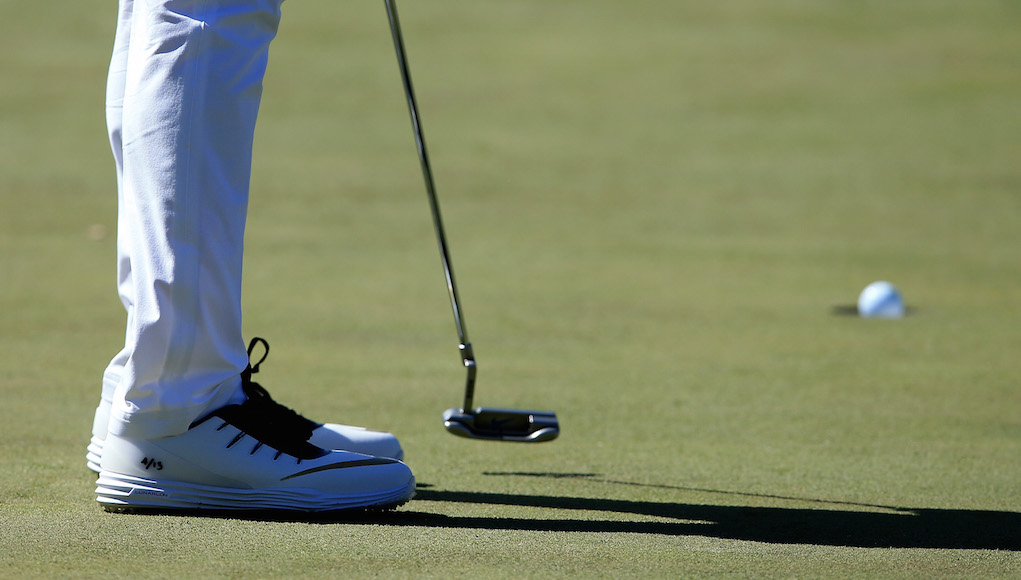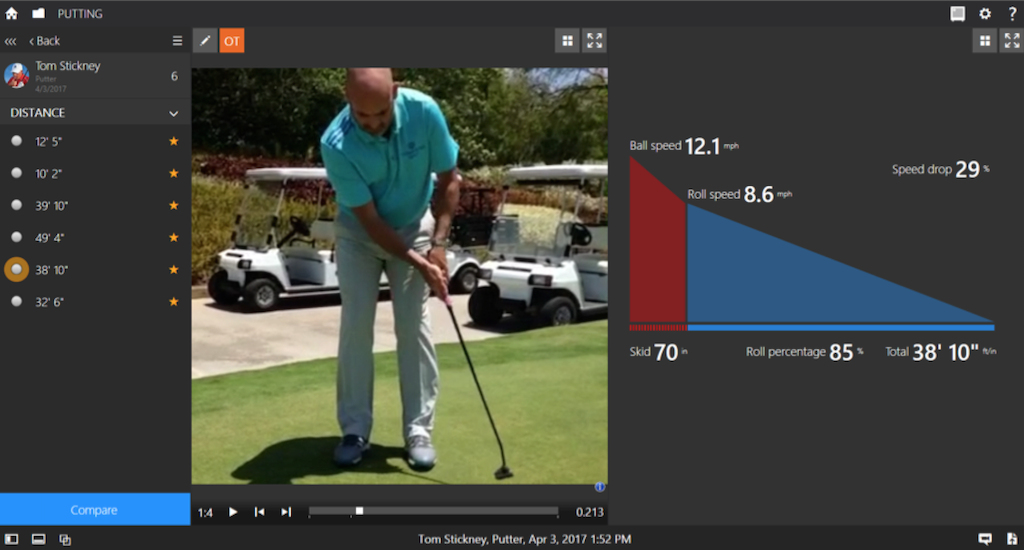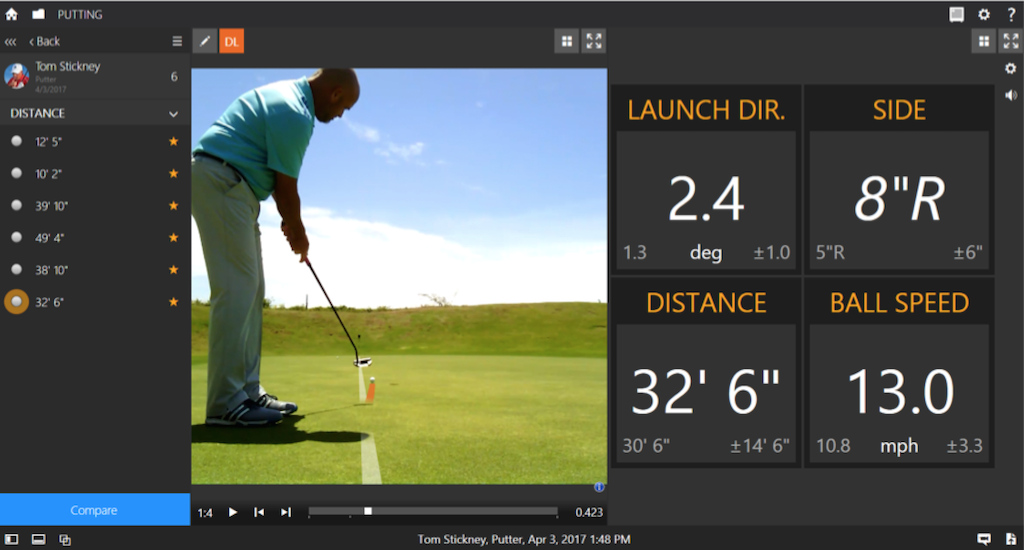Instruction
How to handle Augusta-fast greens

If you’ve been lucky enough to see Augusta National in person, you’ve likely noticed two things about the greens:
- They are flawless surfaces.
- They have amazing undulations with humps, dips and shelves.
As someone who’s putted on Augusta’s greens, I can attest to their pureness. They’re extremely fast and will expose any putting flaw you have. They’re not for the weak-hearted or those with unsteady hands and shaky nerves. Therefore, I wanted to put an article together that will help you to understand how to handle the super-fast greens that you may face in your buddy’s member-guest or your club championship.
I use Trackman’s new putting software to show you two important keys to help you handle fast greens speeds.
Key No. 1
- You must putt the ball with proper impact alignments to eliminate any excessive skid and bounce. This allows the ball to roll quicker and your intended distances to be consistent.

Take a look at a few things in the graphic above:
- The ball left the blade at 12.1 mph.
- The ball bounced/skidded 70 inches before it began to roll.
- The total distance of this putt was 38 feet 10 inches.
- The ball was rolling for 85 percent of its travel.
So what does this all mean?
If you tend to use too much wrist action during your putting stroke a few things will happen; you will add loft to the putter head, you will miss the sweet-spot, the ball will skid/bounce excessively and the ball will have a hard time leaving the blade at the same rate, thus going different distances every time. As a player, this is very difficult because you never know what you are going to get when you hit a putt.
For the sample putt of 40 feet I hit (pictured above), it is imperative that I eliminate loose motion in my hands so I can make a more consistent stroke time after time. And when I do so the ball will roll quicker. For a putt of 40 feet, getting it to roll 85 percent of the way is pretty good. For Tour players and especially Masters participants, it’s not necessarily about the numbers but making the same stroke over and over.
So how do you stop the ball from bouncing and skidding too much? Go to your putting green early in the morning while the dew is still on the green and hit a few putts to the same target. You will see a few dots or “skids” and then a solid line, which is where the ball begins its constant roll. Less dots and a solid line closer to where you’re putting from shows that you’re making a better and more repeatable stroke.
Key No. 2
- You must start the ball where you intend to do so and with the proper speed.

As you look at another putt (above), you can see we’re looking at a few things:
- The ball left the blade at 13 mph.
- The ball started 2.4 degrees to the right of the target (red line).
- The ball finished 8 inches right of my intended target.
- The overall distance of this putt was 32 feet 6 inches… not the 40 feet I had selected.
As stated earlier, you must hit the ball solid enough so you can get a consistent speed off the blade and start the ball on your intended line. As we know, the integration of speed and line is the key to good putting. A perfect stroke is worthless if those two things aren’t accomplished.
In order to start the ball in the correct direction, I would suggest setting up a “tunnel” or archway the ball much go through in order to intersect the hole with the proper speed. Simply putting two tees down on the green and rolling the ball through them is a great drill to help you control the starting line of your putts.
The Takeaway
So what we will see at Augusta this week is the combination of these two fundamentals for successful lag putts:
- The ball will roll as soon as possible.
- The ball will begin on the line that the player picks with the proper speed.
Combining these things together will help players tackle the green speeds they will face this week, and the ones you might face in your tournament. Remember to practice these two parts of your putting game in the ways I have described and I promise you will become a more consistent putter from longer distances.
- LIKE27
- LEGIT6
- WOW3
- LOL0
- IDHT2
- FLOP5
- OB1
- SHANK75
Instruction
Clement: Laid-off or perfect fade? Across-the-line or perfect draw?

Some call the image on the left laid off, but if you are hitting a fade, this could be a perfect backswing for it! Same for across the line for a draw! Stop racking your brain with perceived mistakes and simply match backswing to shot shape!
- LIKE0
- LEGIT0
- WOW0
- LOL0
- IDHT0
- FLOP0
- OB0
- SHANK1
Instruction
The Wedge Guy: The easiest-to-learn golf basic

My golf learning began with this simple fact – if you don’t have a fundamentally sound hold on the golf club, it is practically impossible for your body to execute a fundamentally sound golf swing. I’m still a big believer that the golf swing is much easier to execute if you begin with the proper hold on the club.
As you might imagine, I come into contact with hundreds of golfers of all skill levels. And it is very rare to see a good player with a bad hold on the golf club. There are some exceptions, for sure, but they are very few and very far between, and they typically have beat so many balls with their poor grip that they’ve found a way to work around it.
The reality of biophysics is that the body moves only in certain ways – and the particulars of the way you hold the golf club can totally prevent a sound swing motion that allows the club to release properly through the impact zone. The wonderful thing is that anyone can learn how to put a fundamentally sound hold on the golf club, and you can practice it anywhere your hands are not otherwise engaged, like watching TV or just sitting and relaxing.
Whether you prefer an overlap, interlock or full-finger (not baseball!) grip on the club, the same fundamentals apply. Here are the major grip faults I see most often, in the order of the frequency:
Mis-aligned hands
By this I mean that the palms of the two hands are not parallel to each other. Too many golfers have a weak left hand and strong right, or vice versa. The easiest way to learn how to hold the club with your palms aligned properly is to grip a plain wooden ruler or yardstick. It forces the hands to align properly and shows you how that feels. If you grip and re-grip a yardstick several times, then grip a club, you’ll see that the learning curve is almost immediate.
The position of the grip in the upper/left hand
I also observe many golfers who have the butt of the grip too far into the heel pad of the upper hand (the left hand for right-handed players). It’s amazing how much easier it is to release the club through the ball if even 1/4-1/2″ of the butt is beyond the left heel pad. Try this yourself to see what I mean. Swing the club freely with just your left hand and notice the difference in its release from when you hold it at the end of the grip, versus gripping down even a half inch.
To help you really understand how this works, go to the range and hit shots with your five-iron gripped down a full inch to make the club the same length as your seven-iron. You will probably see an amazing shot shape difference, and likely not see as much distance loss as you would expect.
Too much lower (right) hand on the club
It seems like almost all golfers of 8-10 handicap or higher have the club too far into the palm of the lower hand, because that feels “good” if you are trying to control the path of the clubhead to the ball. But the golf swing is not an effort to hit at the ball – it is a swing of the club. The proper hold on the club has the grip underneath the pad at the base of the fingers. This will likely feel “weak” to you — like you cannot control the club like that. EXACTLY. You should not be trying to control the club with your lower/master hand.
Gripping too tightly
Nearly all golfers hold the club too tightly, which tenses up the forearms and prevents a proper release of the club through impact. In order for the club to move back and through properly, you must feel that the club is controlled by the last three fingers of the upper hand, and the middle two fingers of the lower hand. If you engage your thumbs and forefingers in “holding” the club, the result will almost always be a grip that is too tight. Try this for yourself. Hold the club in your upper hand only, and squeeze firmly with just the last three fingers, with the forefinger and thumb off the club entirely. You have good control, but your forearms are not tense. Then begin to squeeze down with your thumb and forefinger and observe the tensing of the entire forearm. This is the way we are made, so the key to preventing tenseness in the arms is to hold the club very lightly with the “pinchers” — the thumbs and forefingers.
So, those are what I believe are the four fundamentals of a good grip. Anyone can learn them in their home or office very quickly. There is no easier way to improve your ball striking consistency and add distance than giving more attention to the way you hold the golf club.
More from the Wedge Guy
- The Wedge Guy: Golf mastery begins with your wedge game
- The Wedge Guy: Why golf is 20 times harder than brain surgery
- The Wedge Guy: Musings on the golf ball rollback
- LIKE88
- LEGIT13
- WOW6
- LOL1
- IDHT0
- FLOP4
- OB1
- SHANK8
Instruction
Clement: Stop ripping off your swing with this drill!

Not the dreaded headcover under the armpit drill! As if your body is defective and can’t function by itself! Have you seen how incredible the human machine is with all the incredible feats of agility all kinds of athletes are accomplishing? You think your body is so defective (the good Lord is laughing his head off at you) that it needs a headcover tucked under the armpit so you can swing like T-Rex?
- LIKE0
- LEGIT2
- WOW2
- LOL0
- IDHT0
- FLOP0
- OB0
- SHANK2
-

 19th Hole3 weeks ago
19th Hole3 weeks agoDave Portnoy places monstrous outright bet for the 2024 Masters
-

 19th Hole7 days ago
19th Hole7 days agoJustin Thomas on the equipment choice of Scottie Scheffler that he thinks is ‘weird’
-

 19th Hole3 weeks ago
19th Hole3 weeks agoTiger Woods arrives at 2024 Masters equipped with a putter that may surprise you
-

 19th Hole7 days ago
19th Hole7 days ago‘Absolutely crazy’ – Major champ lays into Patrick Cantlay over his decision on final hole of RBC Heritage
-

 19th Hole2 weeks ago
19th Hole2 weeks agoTwo star names reportedly blanked Jon Rahm all week at the Masters
-

 19th Hole2 weeks ago
19th Hole2 weeks agoReport: LIV Golf identifies latest star name they hope to sign to breakaway tour
-

 19th Hole2 weeks ago
19th Hole2 weeks agoNeal Shipley presser ends in awkward fashion after reporter claims Tiger handed him note on 8th fairway
-

 19th Hole2 weeks ago
19th Hole2 weeks agoBrandel Chamblee has ‘no doubt’ who started the McIlroy/LIV rumor and why
















Mark
Apr 23, 2017 at 1:18 pm
I am sure the 93 year old billionaire members all go round in 200 not including mulligans.
ryan
Apr 7, 2017 at 10:20 am
correct line…correct speed…pure roll. Ground breaking stuff
kevin smith
Apr 7, 2017 at 6:51 am
I think the key to the whole article, You must putt the ball with proper impact alignments. square and center strikes. Charley Hoffman said to putt offensively, he had 25 putts yesterday with two three putts. Speed is one thing, massive undulation and speed…shows why they are the best players in the world.
Barry
Apr 6, 2017 at 9:38 pm
So all you have to do is roll it purely on the correct line with the correct speed??
Pingback: Masters Day One Link Roll – It’s Charley Hoffman’s world, DJ bows out & Spieth cards another back nine quad | GolfJay
calheel
Apr 6, 2017 at 5:53 pm
I played in a member guest and the severely undulating greens were rolling 12.2, I putted with my headcover still attached.
The Dawson
Apr 6, 2017 at 3:10 pm
Did anyone need an article to tell them that “The ball will begin on the line that the player picks with the proper speed” is a key to putting well? Not a hater Stickney but this article is paper thin. Also, this key really has nothing to with fast greens or Augusta in particular. I.e., if I go play a dog track with overgrown greens that are slow as hell, I still need to roll the ball on the correct line with the proper speed (by hitting it way harder than I would on fast greens).
tom stickney
Apr 6, 2017 at 12:07 pm
Sorry…at the present time we are compiling Tour Professional data for TM, so there are rough parameters but nothing specific. I will make sure I publish the data as it begins to come out.
C
Apr 6, 2017 at 10:06 am
Line and speed. Yep. Pretty much.
COGolfer
Apr 7, 2017 at 12:19 am
The two most important aspects.
It’s hilarious when we talk about putting on that type of green. Imagine being the weekend worrier that is an amazing putter that has to send the line through a mine field. To compare us to a green that has billiards like consistency is quite disingenuous.
John
Apr 6, 2017 at 9:33 am
As a middle class american, this is good to know for when I get to play there.
freowho
Apr 6, 2017 at 8:27 am
Not sure I got much out of that. In fact pretty sure. Would have liked to see more putts, more data and some comparisons from the best putters on tour. Maybe the effect of ball position or lie angle on launch results.